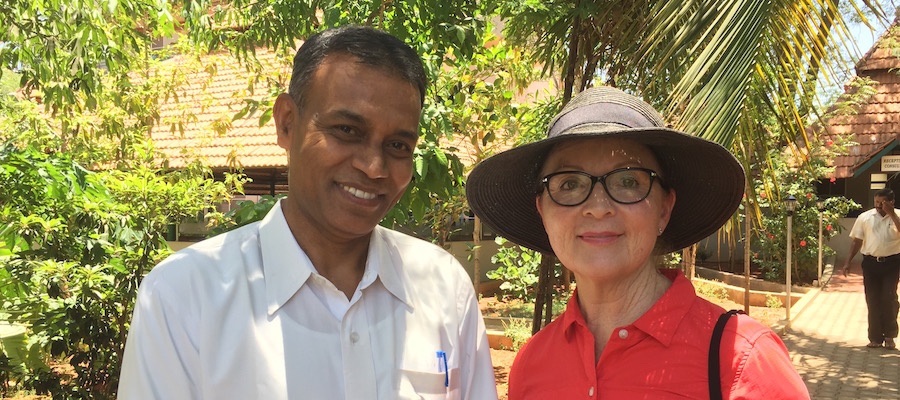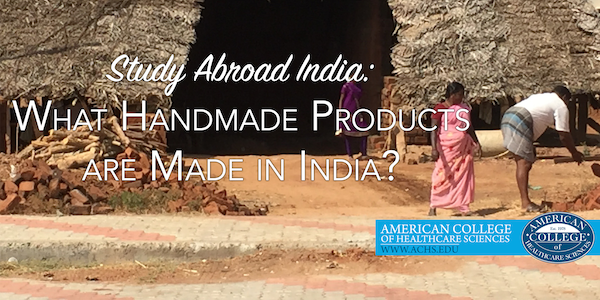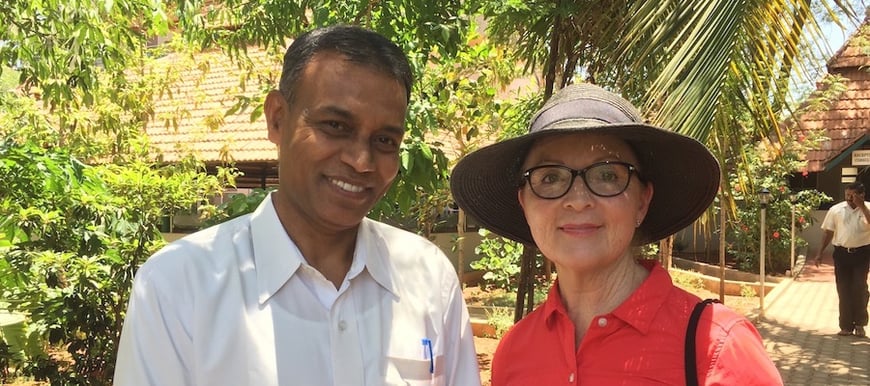
Last April, ACHS President Dorene Petersen and I traveled to the beautiful country of India. One of the highlights of my trip was Prajna Kuteera, a center for Ayurveda and yoga outside of Mysore. As we drove through the crowds and dry, dusty heat, there was nothing around. We were in the very outskirts of town. But then, the center started to reveal itself like an oasis, and we gladly followed a beautiful garden down the drive.
Dr. Krishnamurthy (pictured above with Dorene) appeared like a mirage in the desert to greet us. His grounded, serene demeanor was completely authentic, but almost seemed unreal as he patiently and effortlessly gave us a tour of the facility, gliding as he walked. My cynical Western brain took a momentary side trip. How can someone be so calm, I thought. There’s something to be said for a daily yoga practice and Ayurvedic diet. Even though the doctor was very thin, he appeared to be the picture of health.
The Prajna Kuteera center’s beautiful herb garden was planted to align with the constellations and was stunning. So were the patients staying at the center. Dr. Krishnamurthy introduced us to one elderly woman who gushed about the good doctor and how he and the center were bringing her back to life.
When we were walking away, she called us back and whispered to us, “The purpose of your life is to find self-contentment.” Her words still resonate with me. We are blessed. It’s not hard to understand why we, in the West, are so enthralled with the wisdom of Ayurveda and Eastern holistic practitioners such as Dr. Krishnamurthy. He inspires peace, health, and joy all at the same time!
After the tour we sat down in an open-air dining area for lunch. It was only noon, but the temperature had risen dramatically. Now, I have heard a lot about the benefits of drinking warm liquid when it’s hot outside, but it is still a hard concept for me to wrap my brain around. So when we were served warm water, it was all I could do to drink that first cup. (Once I returned to the States I read some articles about how drinking plain, warm water is an effective digestive tonic. Dylan Smith talks more about this in his article for Everyday Ayurveda.[1])
The next course was another warm liquid soup of sorts, which went down a little easier. And there was yet a third liquid course. In Ayurvedic medicine, how the meal is consumed is very important. The “main course” consisted of rice with a very thin, green liquid poured over the top. It was quite tasty and we could have as much as we wanted. Considering we had been ingesting so many liquid courses, this satisfied my irrational fear of going hungry!
But let me back up and explain a little more about Ayurvedic medicine. According to the National Center for Complementary and Integrative Health:
Ayurvedic medicine (also called Ayurveda) is one of the world’s oldest medical systems. It originated in India more than 3,000 years ago and remains one of the country’s traditional health care systems. Its concepts about health and disease promote the use of herbal compounds, special diets, and other unique health practices. India’s government and other institutes throughout the world support clinical and laboratory research on Ayurvedic medicine, within the context of the Eastern belief system. But Ayurvedic medicine isn’t widely studied as part of conventional (Western) medicine.[2]
My first exposure to Ayurvedic principles was several years ago, when I read Deepak Chopra’s book, Perfect Health. The idea that two patients presenting exactly the same symptoms should be given different care plans based on their unique “mind/body type” (or dosha) resonated deeply for me. This is a very different approach from Western medicine, in which everyone is treated with the same “cure.”
The goal of Ayurvedic medicine is to create and maintain balance: mental, emotional, and physical. You can find Ayurveda sprinkled all over India. It’s the main medical practice of the country, yet each Ayurvedic center has a slightly different focus. At Prajna Kuteera, Dr. Krishnamurthy focuses on serving rural communities and offers education in addition to treatments. It is a humble and modest operation compared to an Ayurvedic center like Kairali Ayurvedic Health Resort, which we also visited.
The surrounding area near Kairali Ayurvedic Health Resort is a paradise. We arrived at night, with dimly lit lampposts guiding our way. There were very few lights at this rustic resort, and it wouldn’t be until morning that we could get a full appreciation of the surrounding beauty.
At this point in our trip, I was a bit annoyed to discover that the lobby was the only building with Wi-Fi. The need to plug in and “touch down” in the familiar of my life became even more acute when I realized availability was limited. Funny how scarcity brings need right to the surface.
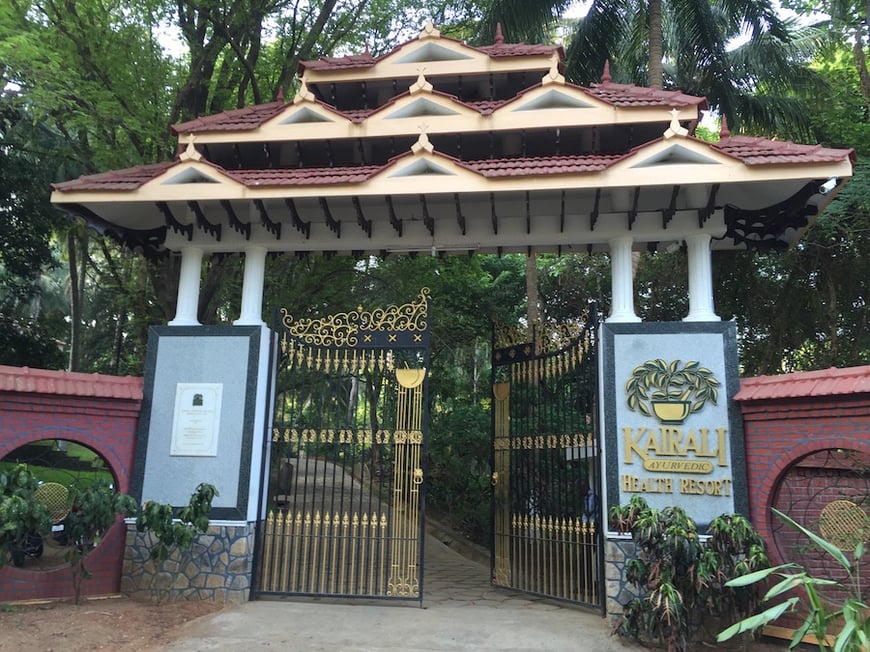
Once we checked in, we were led down winding paths to our side-by-side, stand-alone rooms (or “huts”). I made it a point to memorize the route back to the front desk for a later visit with my computer. Old-fashioned keys were used on these doors, and each unit had its own and very welcomed air conditioner.
As I began to unpack my suitcase, I realized how tired I was. Maybe it was the level of quiet. The only sound was either crickets or cicadas or both, and the not-so-quiet hum of the air conditioner. I think I was asleep before my head hit the pillow.
In the morning, I stepped outside to walk to breakfast and inhaled sharply. It was gorgeous! Lush, green trees, winding paths, and a sprinkling of free-standing huts. It was stunning. I made my way to the dining hall only to find that my travel companion, Dorene, had beat me there. She was in conversation with a travel writer from Germany who had visited Kairali five times, and sang its praises as if she had found the fountain of youth.
Kairali has nine facilities in cities throughout India, as well as 12 additional locations worldwide[3]. Since Ayurvedic doctors use herbs and minerals to balance the body, Kairali has their own factories where these remedies are produced for the various resorts. We were able to take a tour of one factory. The drive took us out into the country, past a large coconut tree farm.
When we arrived, we were met by the young, head Ayurvedic doctor (pictured below with Dorene) and production manager. The head doctor has oversight of the herbal recipes produced at the factory. He also happens to be the local doctor in town. In fact, when we left later that afternoon, he asked for a ride back to the town (about 40 minutes away) so he could start his evening shift at the hospital. I don’t know when he slept!
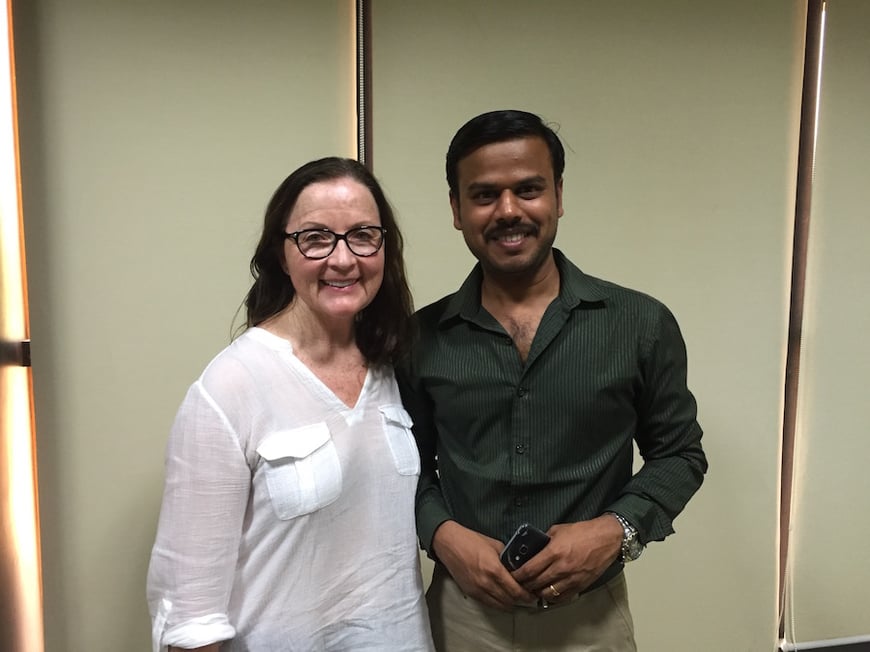
The Kairali factory had no air conditioning and several rooms. One room stored huge gunny-sacks of dried herbs, all marked and neatly organized in rows. In another room women filled pill capsules with powdered herbs. And in yet another, the finished products were labeled, packaged, and prepared to ship. I was struck by how “low-tech” this operation was. Ayurveda keeps processes very close to the earth.
At these two facilities, we were given a taste of Ayurvedic medicine, but we weren’t at either place long enough to actually be evaluated and treated. This is now on my bucket list!
You too can study abroad in India and visit the Prajna Kuteera and Kairali Ayurvedic Health Resort on the 2017 ACHS Study Abroad India tour: Silk, Spice, and Sandalwood. Each traveler will receive a massage or treatment and factory tour at Kairali; lunch and a tour at Prajna Kuteera; and a lecture on Ayurveda in Cochin. To request more information about our exciting study abroad tour in India, click here or the image below!
Disclosure of Material Connection: I am the Community Programs & Events Manager
at American College of Healthcare Sciences, the Institution that publishes this blog. However, all opinions are our own. If this blog contains affiliate links, they will be marked with an asterisk. I am disclosing this in accordance with the Federal Trade Commission’s 16 CFR, Part 255: “Guides Concerning the Use of Endorsements and Testimonials in Advertising.”
This article is for informational purposes only. It is not intended to treat, diagnose, cure, or prevent disease. This article has not been reviewed by the FDA. Always consult with your primary care physician or naturopathic doctor before making any significant changes to your health and wellness routine.
References
[1] Smith, D. (2016, July 26). Shed Toxins with Hot Water: The Best Digestive Medicine. Everyday Ayurveda. Retrieved from http://everydayayurveda.org/hot-water-best-digestive-medicine/
[2] National Center for Complementary and Integrative Health. (January 2015). Ayurvedic Medicine: In Depth. NCCIH. Retrieved from https://nccih.nih.gov/health/ayurveda/introduction.htm
[3] Kairali Ayurvedic Group. (n.d.). Kairali Ayurvedic Group Locations. [Online]. Retrieved from http://www.kairali.com/locations.aspx

